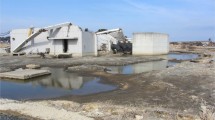Abstract
If the same prototype soil and water are used for a centrifuge model, as it is generally accepted, the seepage velocity in the centrifuge is increased by N times earth gravity produced by the centrifuge environment. The increased seepage velocity produces a time scaling conflict between diffusion time and dynamic time. Many centrifuge researchers prefer not to scale soil particle size; thus, the viscous fluid is used to resolve the time conflict. The purpose of viscous fluid is to maintain the same seepage velocity as in the prototype condition. In other words, the hydraulic conductivity of model soil in centrifuge environment is same as in the prototype condition. For a parametric study, especially, a comparison of test results produced by multiple centrifuge facilities such as the LEAP project, the soil permeability should be consistent. Viscous fluid should be prepared carefully and accurately measured fluid viscosity used for each centrifuge test should be reported because it could affect the soil permeability significantly. It is ideal that the permeability of soil with viscous fluid is measured in the laboratory following ASTM standards before each test. The permeability test should be conducted in such a way that it validates the Darcy’s flow behavior for the hydraulic gradients (and seepage velocity) anticipated in the centrifuge test. Permeability of the sample using the viscous fluid should be reported for each test conducted by each facility. It is unlikely that the permeability will match perfectly between each test but numerical validation can account for the variation of the soil permeability.
You have full access to this open access chapter, Download conference paper PDF
Similar content being viewed by others
If the same prototype soil and water are used for a centrifuge model, as it is generally accepted, the seepage velocity in the centrifuge is increased by N times earth gravity produced by the centrifuge environment. The increased seepage velocity produces a time scaling conflict between diffusion time and dynamic time. Many centrifuge researchers prefer not to scale soil particle size; thus, the viscous fluid is used to resolve the time conflict. The purpose of viscous fluid is to maintain the same seepage velocity as in the prototype condition. In other words, the hydraulic conductivity of model soil in centrifuge environment is same as in the prototype condition. For a parametric study, especially, a comparison of test results produced by multiple centrifuge facilities such as the LEAP project, the soil permeability should be consistent. Viscous fluid should be prepared carefully and accurately measured fluid viscosity used for each centrifuge test should be reported because it could affect the soil permeability significantly. It is ideal that the permeability of soil with viscous fluid is measured in the laboratory following ASTM standards before each test. The permeability test should be conducted in such a way that it validates the Darcy’s flow behavior for the hydraulic gradients (and seepage velocity) anticipated in the centrifuge test. Permeability of the sample using the viscous fluid should be reported for each test conducted by each facility. It is unlikely that the permeability will match perfectly between each test but numerical validation can account for the variation of the soil permeability.
Author information
Authors and Affiliations
Corresponding author
Editor information
Editors and Affiliations
Rights and permissions
Open Access This chapter is licensed under the terms of the Creative Commons Attribution 4.0 International License (http://creativecommons.org/licenses/by/4.0/), which permits use, sharing, adaptation, distribution and reproduction in any medium or format, as long as you give appropriate credit to the original author(s) and the source, provide a link to the Creative Commons license and indicate if changes were made.
The images or other third party material in this chapter are included in the chapter's Creative Commons license, unless indicated otherwise in a credit line to the material. If material is not included in the chapter's Creative Commons license and your intended use is not permitted by statutory regulation or exceeds the permitted use, you will need to obtain permission directly from the copyright holder.
Copyright information
© 2020 The Author(s)
About this paper
Cite this paper
Sasanakul, I. (2020). Soil Permeability in Centrifuge Modeling. In: Kutter, B., Manzari, M., Zeghal, M. (eds) Model Tests and Numerical Simulations of Liquefaction and Lateral Spreading. Springer, Cham. https://doi.org/10.1007/978-3-030-22818-7_36
Download citation
DOI: https://doi.org/10.1007/978-3-030-22818-7_36
Published:
Publisher Name: Springer, Cham
Print ISBN: 978-3-030-22817-0
Online ISBN: 978-3-030-22818-7
eBook Packages: EngineeringEngineering (R0)




